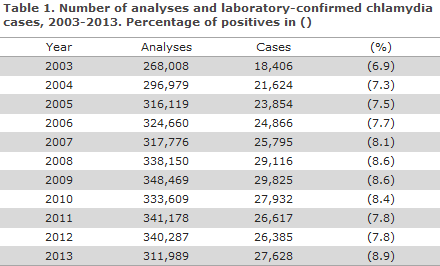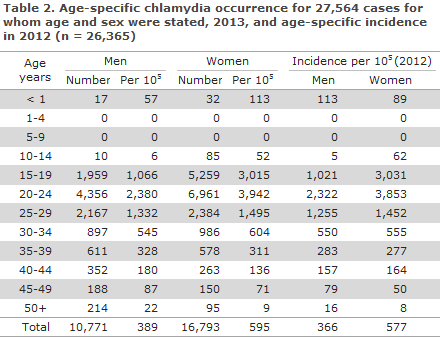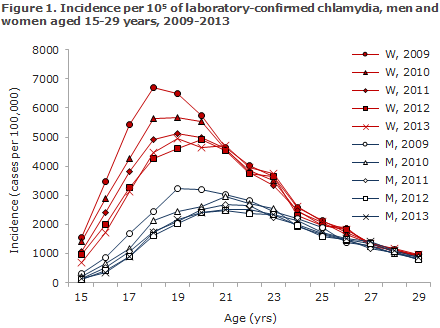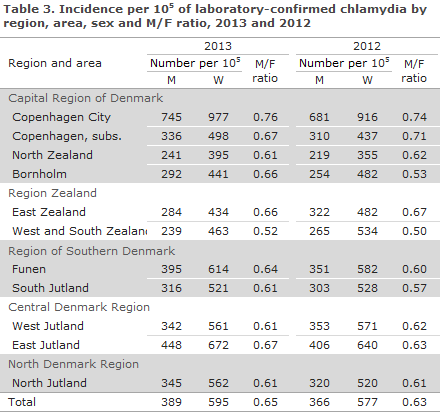No 36 - 2014
Chlamydia 2013
ATTENTION: Due to deficiencies in the chlamydia numbers for 2013 this EPI-NEWS has been revised on July 7, 2015.
Chlamydia 2013
The laboratory notification system for chlamydia (oculogenital infection caused by Chlamydia trachomatis) receives quarterly data on laboratory-diagnosed chlamydia from the clinical microbiology departments and from one clinical biochemical department. 2013 saw the detection of 27,628 chlamydia cases (26,385 in 2012). This corresponds to an annual incidence of 493 per 105 (473 per 105 in 2012 and 479 per 105 in 2011). A total of 311,989 analyses were performed, and chlamydia was detected in 8.9% of those tested, Table 1. The share of positives increased in the 2003-2009 period from 6.9% to 8.6% and then decreased to 7.8% in 2011 and 2012.

As in 2012, a total of 79% of the men and 87% of the women were aged 15-29 years, Table 2. Compared with the numbers recorded in 2012, the sex- and age-specific incidences in the age group 15-19 years increased for men and decreased for women, while in the age groups 20-24 years and 25-29 years they increased for both sexes. In all older age groups there was an increase, except for 30-34-year-old men and 40-44-year-old women. The total incidence increased for men as well as women.

In 2013, the incidences for the one-year age intervals from 15 to 29 years remained practically unchanged compared with the corresponding numbers for 2012, Figure 1. The highest incidence among men was in the 21-year-olds, as in 2012. Among women, the highest incidence was in the 19-year-olds, while it was in the 20-year-olds in 2012. 39% of diagnosed cases were observed in men. This share increased steadily from 23% in 1994 to 38% in the 2009-2012 period.

Geographical distribution
Based on the municipal code of the practice or hospital department performing the test, each individual chlamydia case may be ascribed to a specific region or area, Table 3.

Compared with 2012, the overall pattern was an increase of incidence for both sexes in all regions and areas, with the following exceptions: For both men and women there was a decrease in Region Zealand and West Jutland and for women also in Bornholm and South Jutland. The M/F ratio increased in Bornholm, but otherwise remained largely unchanged.
Diagnostics
A total of 93% of the positive samples were submitted by GPs and 7.6% by hospitals. All cases were detected using DNA amplification methods. Chlamydia was detected in urine samples in 10,146 cases, i.e. 37% of all cases (36% in 2012 and 33% in 2011). Male samples constituted 87% of the positive urine samples (87% in 2012 and 90% in 2011). Urine was used as sample material in 82% of the male chlamydia cases (82% in 2012 and 79% in 2011). All laboratories reported positive findings in urine samples. Rectal chlamydia was detected in 226 men (123 in 2012 and 131 in 2011).
Chlamydia in children
Chlamydia was detected in 144 children under 15 years of age (179 in 2012 and 183 in 2011). Among these, 49 (34%) were less than 1 year old, all of whom had chlamydia detected by sampling from their eye. Among 20 children under the age of 1 year with conjunctivitis, for whom the age was stated in months, 15 were less than 1 month old, four were 1 month old and one was 2 months old. Urogenital chlamydia was detected in one girl aged 12 years, nine girls aged 13 years, 75 girls aged 14 years, and also in two 13-year-old and seven 14-year-old boys. One 14-year-old boy had chlamydia detected through a sample from his eye. The incidence among 10-14-year-old girls decreased from 127 per 105 in 2009 to 52 per 105 in 2013, and for boys the incidence decreased from 11 per 105 in 2009 to 6 per 105 in 2013.
Comment
In 2013 the number of chlamydia analyses was 8.3% lower and the number of detected chlamydia cases 4.7% higher than in 2012 and the positivity rate increased from 7.8 % to 8.9 %. For both sexes and in most age groups the incidence was higher in 2013 than in 2012.
Like the period 2009-2012, the male share of the detected cases was stagnating at slightly less than 40%. As there is no reason to believe that chlamydia is less common among men than among women, this share should be considered too low. Increased testing of men should therefore be continued. Once again, the number of men who had rectal chlamydia detected increased in 2013. When rectal chlamydia is found in a man, he should also be tested for syphilis, gonorrhoea and lymphogranuloma venereum (LGV), EPI-NEWS 20/08.
(S. Hoffmann, Department of Microbiology and Infection Control)
Link to previous issues of EPI-NEWS
03 September 2014